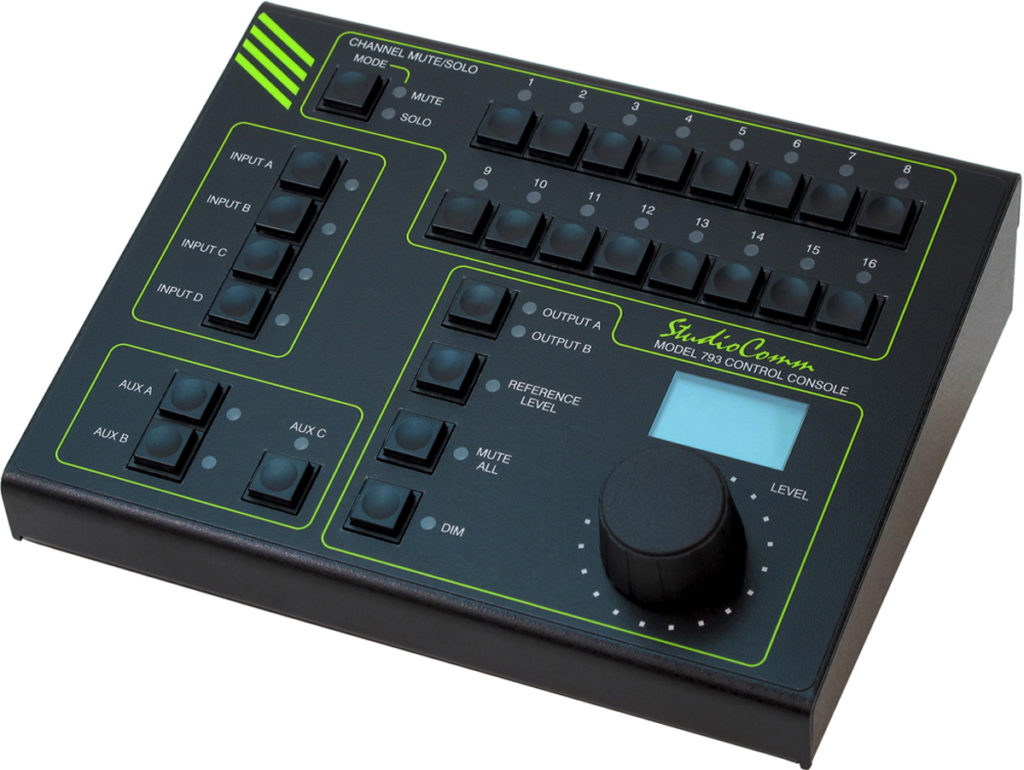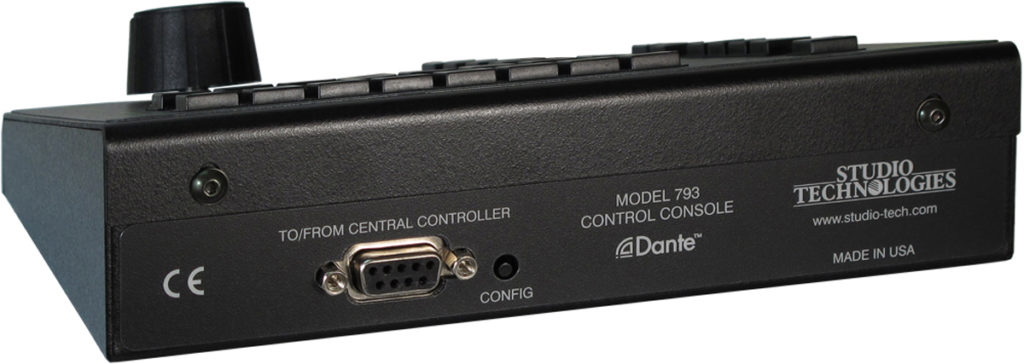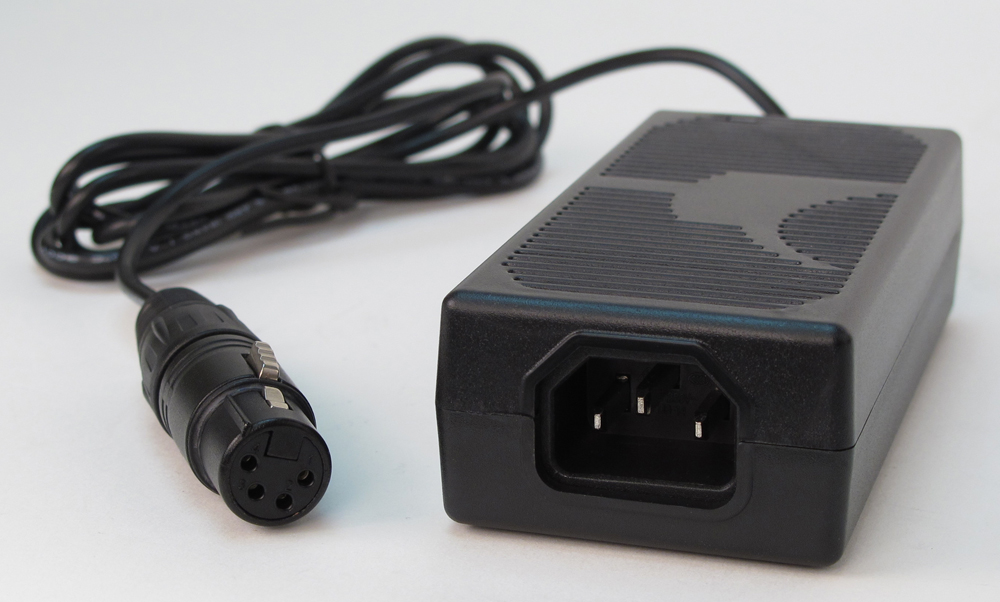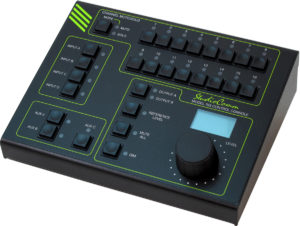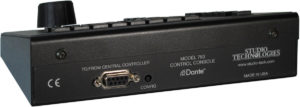Dante digital audio has found wide acceptance in all aspects of audio, from live entertainment and broadcast events, to corporate, recording, and post-production facilities. While certainly a legacy technology, analog audio signals have maintained an important place in the world of professional audio. And the days of needing to support only 2-channel stereo and 5.1 or 7.1 surround formats have ended. The variety of surround formats, and their associated channel counts and arrangements, has expanded the need for specialized equipment. The ability to monitor these Dante digital and analog audio sources in a convenient and sonically excellent way has become a requirement for many applications. Studio Technologies has addressed these needs with the StudioComm with Dante Support system consisting of the Model 792 Central Controller and the Model 793 Control Console.
Rather than supporting a specific surround format, the StudioComm with Dante Support system incorporates an internal 16-channel architecture. This allows a range of surround audio applications to be easily supported. With Dante digital and analog audio inputs, Dante digital and analog monitor outputs, and an extensive set of operating resources it's a simple task to integrate a monitoring system into virtually any contemporary facility. The carefully selected group of features, including both 16-channel surround and 2-channel stereo inputs, configurable input-signal time delays, multiple pre- and post-fader outputs, and mute/solo functions make the system powerful yet simple to operate. And by using the best of contemporary technology, as well as following rigorous design practices, the system's audio quality is excellent.
A StudioComm with Dante Support system starts with the Model 793 Control Console. It's the system's "command center" and is designed to reside at a user's location, allowing fingertip selection of all monitoring functions. Numerous LED indicators provide complete status information. A backlit OLED display indicates key operating and configuration parameters. The second part of the StudioComm system is the Model 792 Central Controller. This one-rack-space unit contains all the circuitry required to support the Dante digital and analog audio input and output signals. It links with the Model 793 using a 9-conductor D-subminiature cable. An integral web server allows fast and flexible configuration of the unit's networking, audio, and Dante performance. This allows the system's performance to be optimized to meet the needs of many specific applications.
Dante audio resources include both surround and stereo inputs and outputs. The Dante surround input and output functions consist of 16 independent channels while the stereo input and output functions support two channels. The Dante channels are compatible with AES67 and support Dante's ST 2110 implementation. Analog audio resources include a 16-channel surround input, a 2-channel stereo input, and a 16-channel surround output.
Great care was taken in designing the system's circuitry, ensuring that the character of the Dante digital and analog audio input signals is preserved. All audio processing is performed in 32-bit logic using a high-speed field-programmable-gate-array (FPGA) integrated circuit. The performance of the analog-to-digital and digital-to-analog functions will meet or exceed virtually any professional audio product. The sonic performance of the StudioComm system is completely "pro" with no compromises.
The Model 792 Central Controller occupies one space (1U) in a standard 19-inch rack. Dante digital audio sources are interfaced using one or two gigabit (GigE) Ethernet network connections that use RJ45 connectors. This arrangement allows switched or redundant Dante operation. A third gigabit network connection provides an independent means of accessing the Model 792's configuration webpages. This ensures that facilities can support separate audio and maintenance networks. Standard connectors on the Model 792 allow simple interfacing with Dante digital audio, analog audio, control console, and power connections. AC mains power is connected directly to the Model 792, with an acceptable range of 100 to 240 V, 50/60 Hz. A source of nominal 12 volts DC can also be connected. If both power sources are connected the AC mains source will provide operating power while the DC source serves as a "hot standby."
Two Surround and Two Stereo Inputs
The Model 792 allows connection of one Dante digital surround and one analog surround signal source. Each surround input allows up to 16 independent channels to be supported with no defined format. This provides flexibility for installations that utilize formats such as 7.1, 7.1.2, 7.1.4, 10.2, 11.1, 11.1.4, etc. Each of the 16 channels associated with a surround input is full-fidelity and, as such, is appropriate to use as a main, surround, back, side, ceiling, or low-frequency enhancement channel. This flexibility allows the Model 792 to be utilized in a variety of applications, including experimental or test formats.
Support for two 2-channel stereo inputs is also provided. A Dante stereo input allows two channels of Dante audio to be selected for monitoring. An unbalanced analog input, located on the Model 792's front panel, allows the output of a "semi-pro" personal audio device to be directly connected.
The audio performance of the Model 792's analog inputs is very good. Low-noise, wide dynamic-range circuitry ensures that the audio quality is preserved. The analog audio signals are routed to high-performance analog-to-digital conversion (ADC) circuitry that supports a bit depth of 24 and sample rates of 44.1, 48, and 96 kHz. A precision voltage-reference circuit helps the ADC circuitry perform highly accurate signal conversion. The audio signals, now in the digital domain, are routed to a high-speed programmable logic (FPGA) device where they are mixed and level-controlled as necessary.
Each of the four inputs, two surround and two stereo, can have a unique name assigned to it. This can be helpful when a Model 793 Control Console user is selecting which input to monitor. In addition, a time delay can be applied to each input, useful for compensating for video processing or display "latency." Delays of up to 999 milliseconds, as related to a sample rate of 48 kHz, can be applied. Each input channel, 36 in total, can be level "trimmed" over a ±20 dB range in steps of 0.1 dB.
Analog Surround Input
The Model 792 provides 16 independent analog input channels which are compatible with balanced or unbalanced line-level sources. These inputs have a nominal level of +4 dBu and are electronically balanced (differential), capacitor-coupled, and ESD (static) protected for reliable operation in demanding applications. Extensive filtering minimizes the chance that radio frequency (RF) energy will cause interference. The analog inputs are protected from damage should a moderate DC voltage be accidentally connected. These characteristics make the analog inputs suitable for use in studio and mobile facility environments. The analog input signals are converted to 24-bit digital and then utilized by the internal logic circuitry. Compatible signal sources include audio consoles, broadcast playback equipment, and analog output ports on routers and networked audio equipment.
Dante Surround Input
The Model 792 provides a 16-channel "wide" Dante input for direct interfacing with applications that utilize Dante technology. As with the Analog Surround Input, the format of the 16 input channels is not defined. Signals with a bit depth of up to 24 and sample rate of 44.1, 48, or 96 kHz are compatible. The Dante surround input channels have a nominal signal level of –20 dBFS.
Analog Stereo Input
A 3-conductor 3.5 mm jack is located on the Model 792's front panel and allows direct interconnection with the output of a personal audio device. The input circuitry is optimized for use with "semi-pro" equipment that has a nominal level of –10 dBu. A rotary level control and two signal-present LEDs enable a user to easily optimize the sensitivity of the input circuitry, matching its performance to the nominal level of the connected source. A high-performance ADC circuit converts the analog signal to 24-bit digital.
Dante Stereo Input
The Model 792 provides two Dante digital audio input channels for interfacing with a stereo source. As with the Dante Surround Input, the Dante Stereo Input has a nominal level of –20 dBFS, a bit depth of up to 24, and sample rate support of 44.1, 48, and 96 kHz.
Three Monitor Outputs
The StudioComm with Dante Support system provides three monitor outputs: one 16-channel Dante digital, one 16-channel analog, and one 2-channel stereo Dante digital. Configuration choices allow the characteristics of the three outputs to be optimized to meet the requirements of specific applications. For flexibility, a configuration menu choice allows the level of each analog output channel to be individually adjusted ("trimmed") over a range of ±20 dB in 0.1 dB steps.
Analog Output
The Analog Surround Output is 16 channels "wide" and can be selected for pre- or post-fader (before or after the level control) operation. These analog output channels are intended for connection to inputs on audio amplifiers or powered loudspeakers associated with a monitor loudspeaker system. Power-up/power-down muting relays help to protect the loudspeaker system from unwanted transient signals.
The analog surround output channels have a nominal level of +4 dBu and are electronically balanced, capacitor-coupled, and ESD (static) protected. High-quality components, including the critical digital-to-analog converters, are used to provide low-distortion, low-noise, and sonically excellent performance. Robust circuitry provides protection from damage should a moderate DC voltage be accidentally connected, something especially useful in broadcast applications. The analog outputs are compatible with virtually all balanced and unbalanced loads with an impedance of 2 k ohms or greater.
The Model 792's analog output channels have a maximum level of +24 dBu. This allows both compatibility and significant headroom in applications where digital
audio input signals with a nominal level of –20 dBFS need to be converted into analog signals that have a nominal level of +4 dBu.
Dante Surround and Stereo Outputs
The Model 792 provides two Dante monitor outputs. One is 16 channels and the other is 2-channel stereo. Each is selectable to be either pre- or post-fader and can be routed (Dante subscribed) to inputs on compatible monitor loudspeakers. They can also be utilized for level metering or other general-purpose uses, typically configured for pre-fader operation. The nominal level of the Dante monitor outputs is –20 dBFS. Each Dante output channel can have its level individually adjusted ("trimmed") over a range of ±20 dB with a step size of 0.1 dB.
Dante Performance
Two of the Model 792's three gigabit Ethernet ports are utilized by the Dante audio interfaces. These ports can be selected, using the Dante Controller software application, for switched or redundant Dante operation. Support is provided for both AES67 and Dante Domain Manager™ (DDM) operation. The Model 792 will also support Dante's ST 2110 implementation.
The StudioComm with Dante Support system allows the Dante audio sample rate to be selected for 44.1, 48, or 96 kHz with a bit depth of 24. The Dante Controller software application is used to route (subscribe) the Model 792's receiver (input) and transmitter (output) channels with the associated Dante compliant-equipment.
Operation
The Model 793 Control Console provides the operator with an easy-to-use interface and includes a set of pushbutton switches, a rotary control, and a backlit OLED graphics display. Together these resources are used to select the desired monitoring environment. User functions include selecting the input source, adjusting the listening level, selecting the monitor output, and activating other special features. The four audio inputs, two 16-channel surround and two 2-channel stereo, can be individually selected for monitoring. Although only one is typically selected to be monitored at any one time, for flexibility two, three, or all four can be combined (summed) and monitored. The rotary control (actually an encoder with 30 steps per rotation) allows adjustment of the monitor output level in 0.5-dB steps.
For content confirmation, each of the unit's sixteen channels can be individually muted or soloed as desired. Multiple channels can also be simultaneously muted or soloed and needed. A reference level value can be saved and then enabled by the operator, allowing the monitor output level to be directly returned to a known value. A mute all function simultaneously mutes all sixteen output channels. The dim feature allows the operator to attenuate the monitor output level from among four configurable values. The graphics display will show a variety of system-related information. This includes the text names that have been assigned to the input sources and output destinations. The display will also show the current monitor output level directly in dB. Pressing the rotary control's knob will cause the management port's IP address to display, helpful when configuring the StudioComm with Dante Support system.
LED indicators are provided on both the front and back panels of the Model 792. These relate to selected performance characteristics of the Ethernet interfaces, Dante interface, general system activity, and levels of the unbalanced stereo audio input. They can be useful during installation, troubleshooting, and operation of the StudioComm system.
Special applications can take advantage of the Model 792 Central Controller's ability to be controlled using an API running under an operating system on external computer hardware. Using HTTP, in the form of sending GET or POST HTTP requests, all Model 793 Control Console user control functions can be duplicated using a software-based application. These HTTP requests will interface with the Model 792 by way of the management Ethernet interface.
Simple Installation
The Model 792 Central Controller uses standard connectors to allow fast and convenient interconnections. Gigabit Ethernet connections are made to local area network (LAN) ports using three RJ45 connectors, two for Dante and one for management. Multiple LEDs on the unit's back panel display the status of the network connections. Four 25-pin female D-subminiature connectors are used to interface with the unit's 16 channels of analog surround input and 16 channels of analog monitor output. A 3-conductor 3.5 mm jack, located on the Model 792's front panel, allows connection of a source of unbalanced stereo audio.
A detachable power cord is used to connect the Model 792 to a source of AC mains power. A DC power source can be connected using a 4-pin XLR connector. The lightweight aluminum enclosure mounts in one space (1U) of a standard 19-inch rack enclosure. An interconnecting cable with 9-pin male D-subminiature plugs on each end are used to interconnect the Model 792 Central Controller with the Model 793 Control Console. An interface cord with an approximate length of 20 feet (7.3 meters) is included with each StudioComm system. The standalone Model 793 Control Console is typically placed on a surface that allows easy operator access.
AC and DC Power
The Model 792 allows an AC mains source of 100-240 V, 50/60 Hz to be connected by way of a detachable power cord. The unit can also be powered using a 12 volts DC source that is connected via a broadcast-standard 4-pin XLR connector. If both the AC and DC power sources are connected the Model 792 will be powered by the AC mains supply. Only if the AC mains source fails will a load be placed on the DC source. The Model 792 Central Controller provides a current-limited source of 12 volts DC power for use by the Model 793 Control Console.
Future Capabilities and Firmware Updating
Both the Model 792 and Model 793 were designed so that their capabilities can be easily enhanced in the future. A USB connector, located on the Model 792's back panel, allows its main and FPGA firmware (embedded software) to be updated using a USB flash drive. The Model 792 uses Audinate's Brooklyn II module to implement its Dante connectivity. The firmware in this module can be updated via the unit's Ethernet connections, helping to ensure that the Dante capabilities remain up to date. The Model 793 also utilizes a USB connector, located inside the unit, to allow its main firmware to be updated. All firmware files and configuration parameters are securely stored in non-volatile memory.




